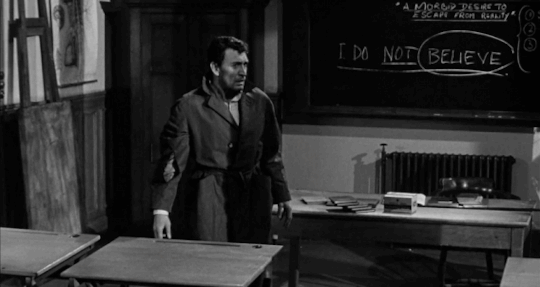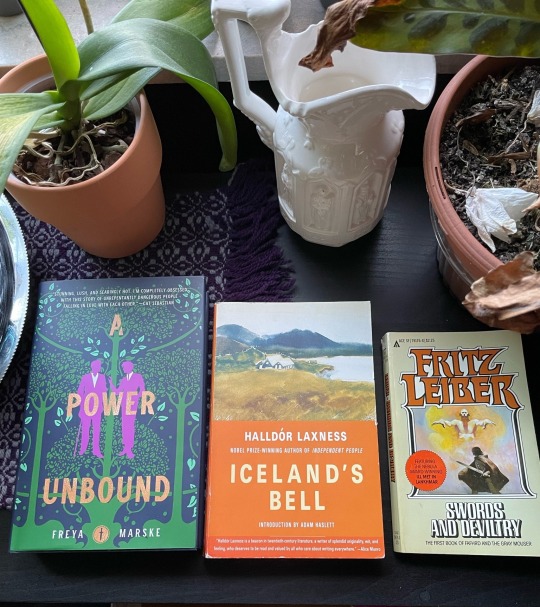#Fritz lieber
Text

Art by Tim White for Gather, Darkness! by Fritz Leiber (1979)
1K notes
·
View notes
Photo

Fafhrd and the Grey Mouser, with their patron wizards, Sheeba of the Eyeless Face and Singable of the Seven Eyes.
#Fafhrd#Grey Mouser#Sheeba of the Eyeless Face#Singable of the Seven Eyes#Nehwon#Fritz Lieber#sword and sorcery#Mike Mignola
46 notes
·
View notes
Note
sorry, i hope you don't mind, but a few days i also remembered the story about the kitten and the coffee and looked it up. if you're curious, it is Spacetime for Springers by Fritz Lieber.
Omg, yes that is the story I was thinking of! Thank you so much, Arden! <3 I knew it had a strange name that I wouldn't remember in a million years, lol!
I found the story here if anyone wants to read it. The formatting is a bit wonky in a few places, but it's totally readable. (For context: in the tags of this post I mentioned it reminded me of a short story about a kitten and coffee.)
#it's rather bittersweet in a way#but Lieber clearly knew cats very well#I should mention there is some sexism though I've read a lot of classic sci-fi that was much much worse on that front#thanks again Arden for letting me know which story it was!#sci fi#Space-Time for Springers by Fritz Lieber
1 note
·
View note
Text
Fantasy Cities Volume 1

Around a year ago, I published a series looking at city settings from various fantasy games. I looked at 7 cities including Doskvol, Spire, Eversink, The City from a|state, Into the Cess and Citadel, Infinigrad, and Endon from Magical Industrial Revolution. I’ve now taken those 7 essays and expanded and improved them, added 2 more essays on Lankhmar from DCC’s boxed set and Freeport, a Pathfinder 1e city from Green Ronin. This PDF, Fantasy Cities Vol 1, is available now on my patreon.
Here’s an excerpt from the introduction
In the history of the fantasy genre, cities have an interesting place. Tolkien’s Lord of the Rings, which created so much of what we consider generic about fantasy, doesn't really care for cities. Which makes sense because the books themselves feel like an elegy for a time before industrialization, a love letter to the countryside - to woods and streams and the sands below your feet. The cities of Middle Earth are, at their best, noble and static, and at their worst, corrupt and fallen to the hubris of man.
The earliest thriving fantasy cities are probably in the sword and sorcery of writers like Fritz Lieber or Michael Moorcock. These stories were influenced by, among other things, the machismo of pulp magazine stories. The cities reflect this. At their best, they're a canvas for male bravado and havens for debauchery and dissolution. At their worst, they're predatory and authoritarian.
In modern fantasy, the city is ascendant. The old tropes withered under post-modernism's sarcastic glare. Now, you get Ankh-Morpork and Bas Lag and many more that capture the contradictions, potential, and romance of cities as places to spend your lives. But what about games? A city in a novel has to be interesting on the page. A city in a game has to be interesting at the table, it has to bear the weight of the imagination of 3-5 people over a shitty internet connection. That's where I started the series affectionately known (by me) as WWTAWWTAC (pronounced whatawhatac), i.e. What We Talk About When We Talk About Cities.
And here’s an excerpt from the new entry on Lankhmar:
Creating a roleplaying game supplement for an existing fantasy city is tricky. It's trickier when it's a place as famous as Lankhmar, the City of the Black Toga, the City of Sevenscore Thousand Smokes. Not only are the stories well-loved, the city is an inspiration for other well-loved cities, notably Discworld's Ankh-Morpork which started out as a loving pastiche before evolving into something deeper. (Even the word "ankh" comes from Lankhmar). This means that you have to walk the line between giving fans what they want and making it a useful, usable supplement. Basically, DCC's approach is to not invent any new lore whatsoever - as far as I can see. They lay out what Leiber's originally stories say about Lankhmar and then give themselves permission to colour within the lines with small, inoffensive details. The end result isn't radical or surprising but it does seem genuinely quite good.
I’ve titled it Volume 1 because if we hit the patreon drive’s goal, I’ll do a Volume 2. Maybe I can finally tackle Waterdeep or Ptolus. Maybe I can expand to cities in novels and actually compare them to cities in games directly. Maybe I can look at cities in video games. Where does Dunwall from Dishonored end and Duskwall begin? There’s lots of things to explore!
Thanks to the 30+ folks who signed up last week, we’re currently at 94 out of 150. So if you’re doing okay and able to support, please head over to patreon and subscribe!
Link: https://www.patreon.com/posts/fantasy-cities-1-94754443
125 notes
·
View notes
Text
Kieran being an emotional vampire raises some questions when it comes to redemption arcs. Namely, how is he going to eat if the evil thing he was doing was stealing and breaking hearts? Like, literature depictions of emotional vampires all inherently hurt people or cause bad feelings in them, especially since Kieran might be based off of The Girl with the Hungry Eyes by Fritz Lieber, where the vampire in question causes people to have heart attacks.
Is he going to have to go the same route as Draculaura where he just... refuses to eat the one (1) thing that he’s SUPPOSED to eat? That sounds like a bad idea, both because it makes Draculaura’s blood phobia less of a unique quirk and more of a moral obligation, and because it implies all of the vampires have to starve themselves to be morally good, which is a very harmful message
or is he able to eat just a small amount at a time? Like, does it have to be love/heartbreak/whichever one he actually feeds off of or can it be anything? Could he get into a relationship and take very small amounts of love each time? Could he just send a cursed meme or a bad joke to the groupchat and feed on the anger directed towards him? Can he take a bit of the edge off of other people’s intense emotions and cool them down a bit as a way of feeding instead of just removing them altogether?
the wiki says in his diaries he learned what true, genuine love is like and he considered getting a pet because they give unconditional love. so I guess maybe he can just soak up the emotion like a sponge instead of actually breaking hearts for it? maybe? but at that point what makes him different from just a human teenager that needs positive attention to grow up healthily
#monster high#the wiki implies he can drink blood but i doubt that slightly. like i can't disagree but no emotional vampire ik of can#plus him being ABLE to doesn't mean it's... a GOOD IDEA#like how Drac probably isn't perfectly healthy due to her diet but... she's still not technically hungry#like maybe she has a vitamin deficiency but strawberry milk and fruit juice is getting her through class well enough#and maybe Clawd can eat things that aren't meat but it's not safe to try and cut meat out entirely#and Dracula (actual novel Dracula) can go without eating for long periods of time but it makes him noticably weaker#so like. if kieran is an emotional vampire he SHOULDN'T avoid eating emotions just because he COULD feed on something else
14 notes
·
View notes
Text
Do you believe?

Happy to find this from the Netflix🙏. Night of the Eagle is a 1962 British horror film directed by Sidney Hayers. The film was retitled Burn, Witch, Burn! for the US release.

Another (Low budget) film Weird Woman (1944) is also loosely based on Fritz Lieber’s 1943 novel called Conjure Wife. Leiber’s novel was first published in 1943, and has become the inspiration for several other films including the British film Night of the Eagle (1962) and the American comedy Witch’s Brew (1980).(Greene 2018, 84.)

🦅”When we first meet the professor (played by Peter Wyngarde), he is intoning the words “I Do Not Believe” as he inscribes them on a blackboard for his students, the objects of his disbelief being the supernatural, witchcraft, superstition, and the psychic, all of which, he says, demonstrate “a morbid desire to escape from reality” which can only exist in an atmosphere of belief. After nailing his colours to the mast in such uncompromising fashion, it is quite clear that Professor Taylor, like his fellow sceptic Dr. John Holden in Night of the Demon, is well on course for a rude awakening. (Exshaw 2007.)”

⭐️⭐️⭐️⭐️I loved this movie in so many ways. First of all it presents many of my❤️ subjects: Elitism - Psychiatry & Realism vs. Primitive Superstition, and there are a lot of questionable gender & culture issues i.e. a lot of things to study🙂Visually stunning!

🕷️Night of the Eagle depicts the use of charms or supernatural powers in an “everyday” environment and juxtaposes it with a rationalist view which is questioned during the progress of events. Freud developed the notion of the ‘unheimlich’ as a source of fear: something uncanny or ‘unhomely’ – the familiar made strange.(Botting 2013.)

“a remarkably effective piece of trickery considering the date of the film and its obviously limited resources. (Exshaw 2007.)”


Sources
Greene, H. 2018.Bell, Book and Camera: A Critical History of Witches in American Film and Television
Botting, J. 2013. Why I love... Night of the Eagle. https://www.bfi.org.uk
Exshaw, J. (2007). Night of the eagle. The Irish Journal of Gothic and Horror Studies, (3), 107-108.
Spoiler Alert in Trailer!🚨
youtube
#witch#witchcraft#movies#witches#horror film#cinema#horror#film#psychology#psychoanalysis#great britain#Youtube
3 notes
·
View notes
Text

A Spectre is Haunting Texas by Fritz Lieber
Cover by Richard Clifton-Dey
2 notes
·
View notes
Note
Is it just me or does it seem like the older Frank Herbert got the harder it was for him to hide his fetishes? The amount of breeding programs and the existence of Honored Matres gets very hard to ignore
eh, it's not like eugenics and breeding programs were a new development in the later books. Besides, my standard for that is Fritz Lieber. Any fetishism that may or may not be in the Dune books is a candle to an inferno
3 notes
·
View notes
Text

Warburgs Staatstafeln
1.
In dieser Woche werde ich anfangen, am Max-Planck-Institut für Rechtsgeschichte und Rechtstheorie in Frankfurt zu arbeiten.
In den letzten Jahren war es vor allem die Zeit als Vertreter eines Lehrstuhls für Geschichte und Theorie der Kulturtechniken in Weimar und die sechs mit Markus Krajewski durchgeführten Geschichte-und-Theorie-WGs (das sind Wohn- und Wandergemeinschaften) in Sils Maria und auf schweizer-italienischen Schmugglerrouten, die dazu geführt haben, dass ich weder systematisch noch allgemein arbeite. Sagen wir es ruhig so: im Allgemeinen arbeite ich nicht. Systematisch arbeite ich nicht. Sonst schon, gerne in Schichten und theoretisch.
Ich arbeite an und mit Formen, Zeiten und Orten, die manche klein nennen könnten, wie etwa auf Zetteln, in der Nacht oder an Bars. Lieber protokolliere ich, als einen Text zu verfassen. Ich arbeite nur von Fall zu Fall, euphemistisch gesprochen kasuistisch oder exemplarisch. Ich abstrahiere zwar, aber eingefühlt in eine Fülle von Zeug, zu dem Wiethölter mal treffend angemerkt hat, das sei too much too soon. Ich verstehe das so: Wenn es abstrakt ist, dann ist es auch satirisch. Es sind Kleinigkeiten, zu klein, um eine große Anreicherung oder eine große Bereicherung füttern zu können. Sie füttern allenfalls das, was Georges Didi-Huberman die Unersättlichkeit nennt.
In allen Fällen sind Theorie und Geschichte in meinen Vorstellungen nicht groß getrennt, sie kommen aneinander und 'durch einander' bzw. 'durch das jeweils andere' vor. Vielleicht sind Theorie und Geschichte "verhäkelt" (Nietzsche) oder "verschliffen" (Ladeur). Wenn darin mal das Allgemeine oder ein System auftaucht, dann auch nur 'verhäkelt' oder 'verschliffen' mit Besonderheiten, Einzelheiten, Details, Zufälligkeiten, Äußerlichkeiten oder Bleibseln und mit etwas, was nicht systematisch ist. Ob nun 'Gerechtigkeit als Zufall' oder 'Bildregeln', also Regeln, die 'nur' Bilder sind, ob es um beispielhafte Fälle zum Einsatz von juridischen Techniken (wie etwa bei Fritz Schulz, einem Coen-Film, bei Hermann Jahrreiß oder aber in den Fallsammlungen zur Suggestivkraft bei dem Vater des Kinorechts Albert Hellwig geht) - ich klebe an Details, die im Allgemeinen nicht aufgehen und denen für das System die Pointe fehlt. Am Ende bleibt allenfalls ein flatterndes oder fliegendes Auge und die Frage: Quid tum? Das kann man auch so übersetzen: Und nu?
Meine These ist, dass das zu den Spezialitäten einer Geschichte und Theorie des Rechts gehört (und so auch schon bei Beratern wie Alberti, von dem das Motto stammt) auftaucht. Eventuell ist das nicht so weit entfernt von Ladeurs Vorstellung einer Kultur, die irritiert. Eine gründliche Geschichte steht wie eine gründliche Theorie knietief im Bodensatz der Gründe, sie sind beide sedimentär geschichtet. An beidem interessiert mich dasjenige, was auch Gegenstand für Archäologie (inklusive der Warburgschen Seismographie) oder für eine 'vergleichende Meteorologie' sein könnte. Das wäre vergleichende Normwissenschaft, wobei die Normen zwar sitzen könnten, aber auch dann Schwebeteilchen und Sediment wären. Das 'MPI für Geschichte und Theorie des Rechts' (darf man das privat so umbenennen?) könnte ein guter Ort dafür sein.
2.
Aus Warburgs Staatstafeln lässt sich die Geschichte und Theorie eines vagen und polaren Rechts extrahieren. Das ist in diesem Fall erstens ein verschlungenes und verschlingendes Recht, das Vage hat in diesem Fall also etwas mit dem Verzehr zu tun. Zweitens hat das Polare mit etwas zu tun, was (sich) wendet, kehrt, kippt , schwankt oder dreht. Rom ist hier nicht nur polis, Rom ist auch (wie es bei Heidegger schon heißt) polos. Das römische Recht, von dem man hier etwas zu sehen bekommt, ist das Recht einer Stadt, die Katja Maria Vogt kosmisch genannt hat (sie spricht in Bezug auf die Stoa von einer cosmic city) und einer Gesellschaft, die - wie Karl-Heinz Ladeur sagt- multipolar ist. Dieses Recht sitzt keiner Stabilität auf, es sitzt Instabilitäten auf. Es sitzt auch keinem (ökologischen) Gleichgewicht auf, sondern 'Ungleichgewichten', es ist nicht 'ausgewuchtet'.
Ich unterstelle dabei, dass auch Aby Warburg schon bild-und rechtswissenschaftlich gearbeitet hat. Was Bild- und Rechtswissenschaft von Bildern und von Recht wissen, ist ohnehin sekundär, selbst wenn die Wissenschaft an Originale gerät. Auch was die Praxis weiß ist sekundär, selbst wenn sie es ist ist, die das historische Material oder eben die sog. Quellen produziert. Die Abstufung zwischen einem laienhaften Wissen und einem professionellen Wissen, also etwa der Hinweis, dass Aby Warburg kein Jurist oder kein Rechtswissenschaftler gewesen sei, sich keiner juristischen Methode bedient hätte, der ist sicher wichtig wie jeder Hinweis. Das ändert aber nichts daran, dass er mit den Staatstafeln etwas vom Recht weiß, etwas vom Recht zeigt. Im übrigen arbeite ich nicht unter dem Dogma der großen Trennung und unterstelle allenfalls, dass das Recht zwar ausdifferenziert sei, aber nur zum und nur im Schein.
5 notes
·
View notes
Note
hello Fritz! Can I hug ya?
Ich würde lieber nein, But I'll allow it just zhis once
1 note
·
View note
Text

Wahnsinn, ich gehe das erste Mal auf deine Seite, Deinen Blog, lieber Michael Antoni, und da begegnet mir sofort Fritz Riemann, dessen Werk ich verschlungen habe damals, ja wann eigentlich, ungefähr, als ich auch dir das erste Mal auf YouTube begegnet bin.

0 notes
Text

Think I might make more of an effort to log my reading for this year—these are the books I read in January. I’ve been focused on reading books I’ve already bought instead of ordering new ones from the library, so the selection will reflect that.
1. A Power Unbound, Freya Marske, 2023. Historical-Fantasy-Romance, third book in the trilogy. I enjoyed these books, mostly as low-stakes reading around the holidays, and this one wraps up the series nicely. My only issue is that I had a lot of hangups with the historical bits, which is partially because that's the sort of thing that sticks in my brain, and partially because when you are blending multiple genre conventions it's inevitable that one of them is going to get short shrift at some point. I also got stuck on the fact that the plot reinforced the idea of Italian Catholics as being Bad and Superstitious even as the Italian Catholic character keeps calling out the (presumably Anglican) Brits on their xenophobia, which I don't think was intentional. Anyways, if gay fantasy romance set in Edwardian England sounds like your thing, they're worth checking out. The setting and characters are generally a fun time.
2. Iceland's Bell, Haldór Laxness, 1943. I bought this on a total whim, based on the fact that it's historical fiction set in a time (late 16-early 1700s) and place (Iceland) that I don't usually see in English-language historical fiction. I had no idea what to expect AND I LOVED IT. It loosely follows several characters, all based on or lightly modified from historical figures: a farmer trying to get his murder verdict overturned, a noblewoman with financial and romantic problems, and a nobleman who was responsible for collecting and documenting a bunch of important old Icelandic manuscripts (including some of the Eddas, I think). He also gets involved with the first guy’s court case and is part of the second lady's romantic problems. This book slaps. The author won a nobel prize for a different book, so I guess I shouldn't be surprised, but man it was so good. One guy walks all over half of Northern Europe, almost dies multiple times, runs away from some Germans, generally has a real bad time. The other guy collects books and Feels Bad About Old Iceland. (Actually everyone does this). I appreciated that even though the lady is, at times, A Metaphor, she has a lot of personality and doesn't just exist to Suffer Nobly (and horribly, in a sexual way), as is the case for at least several other books I can think of that deal with the kind of Great Tale that is also A Metaphor for The Country (The Tale of Kieu, This Earth of Mankind). It helps that every man in this book is kind of useless. You should read this.
3. Swords and Deviltry, Fritz Lieber, 1970. I've been on a sword and sorcery kick lately, so I thought I should read some of the Fafhrd and the Gray Mouser stories. I always have a hard time figuring out where to start with these kind of long-running stories, because usually the first one published isn't naratively the first story. I figured it was easier to go with the collections in order, which rearranged the stories into a narrative chronological order, which might have been the wrong decision for me. I liked these stories, but I feel like they aren't really the core of why people were drawn to the characters in the first place, since they are all prequels written after the characters were already known. I'll probably check out more later, but this collection was generally just "fine."
1 note
·
View note
Text
407. Various Authors - Dragon #100 (August 1985)

Finally the 100th issue of Dragon magazine! And this makes it a particularly special one, with some new stuff and an interesting cover. The cover might look like early CG but it really isn't (computers couldn't do this level of image smoothness in 1985), it's a paper sculpture by Dennis Kauth with the central faery dragon painted purple after being photographed. Pretty original as befits a special issue.

The central part of this issue is the reveal of Gygax's Gord the Rogue novels, a series that wasn't anywhere as successful (and frankly as enjoyable to read) as either the Dragonlance or the future Forgotten Realms novels, it also got suspended after the second volume as Gygax left TSR in less than friendly terms. He would go on to publish five more novels under the New Infinities label (Gygax's new TTRPG company after TSR). In this issue we get the introduction to the character through a short story which is, curiously, set after the upcoming first novel and before the second (which would come out in 1986). It's not the best short story, but you get a sense for the character and Chert, his Barbarian friend. In the introduction Gygax says that only now does he notice the similarities between these two characters and Fritz Leiber's Fafhrd and the Grey Mouser... well... sure, Gary. (I'm actually reading the first novel, Chert hasn't shown up yet, and both the character of Gord and the city of Greyhawk feel extremely indebted to Lieber, it can't be a "coincidence".

Anyway, we also get a poster of the book cover, and other cool articles, such as part 5 of Ed Greenwood's Pages from the Mages, where we get another bunch of grimoires, a really long adventure called "The City Beyond the Gate", rules for Dragonchess by Gygax, Douglas Niles discussing the creation of Battlesystem. A good celebratory issue.

1 note
·
View note
Text
Lankhmar and the Origins of Adventure Fantasy
Fritz Leiber’s Lean Times in Lankhmar is a sword and sorcery short story that is part of the Fafhrd and Gray Mouser series. The Series had a huge impact on the development of the Sword and Sorcery Genre and the term for the genre itself comes from Lieber. The story is set in the city of Lankhmar, a metropolis full of scheming factions and false gods. Fafhrd and Grey Mouser begin the story by arriving in the city of Lankhmar and split apart as their friendship has fallen apart over a disagreement of loot splitting. Both find new routes in the city with Gray Mouser entering the service of Pulg, a mob leader who gets money from the small religions of the city.Fafhrd became an acolyte for the church of Issek of the Jug. Mouser eventually has to rob the church Fafhrd works and the two reunite as opponents but eventually things resolve with Fafhrd attaining apotheosis, becoming a living god, and Pulg ends up serving Issek The two eventually leave with the money.
Lean Times in Lankhmar serves as a sword and sorcery template for novels such as Alyx by Joanna Russ and Michael Moorcock’s Elric Series. Most significantly, Leiber’s work was a major influence on Dungeons and Dragon, With TSR putting out adventure supplements set in Lankhmar and the world of Nehwon. This influence creates an image of fantasy that has bled into the mainstream perception of fantasy literature. Leiber writes in an immersive style, much of it sounding like descriptions of a D&D scenario, this is seen with the naming conventions of characters such as Gray Mouser, Muulsh the Moneylender. These names evoke images and associations that stick in the mind and immerse the reader as it makes the character sound as if they are a part of the world and have a reputation. The immersion is also seen in the allusion to another Fafhrd and Gray Mouser story in referencing the Year of the Feathered Death, giving a sense of continuity to the stories and sewing the plots into the fabric of the setting. This sense of immersion plays into a reminder of DnD as it reminds readers of the shared connected worlds and stories of the role playing game. It also adds immersion as it allows the reader to speculate on what the Year of the Feathered Death was if they’ve never read that tale similar to the allusion to the Clone Wars in the original Star Wars where there was nothing but the allusion until the Prequel Trilogy fleshed out the Clone Wars. Leiber’s approach to immersion is akin to throwing you into the world and letting the reader figure it out rather than using exposition to accomplish this. Depending on the reader, the show not tell approach can be an effective tool for immersing the reader but for other readers this can pull them out of the narrative. Leiber’s characters also set up archetypes that are seen within Dungeons and Dragons, Fafhrd being the large northern warrior who is honorable and brave, Gray Mouser is the sly rogue who uses wits and deception to achieve success, both of these are common character types in fantasy and within Dungeons and Dragons. The competing priests and faction also plays into this as characters like Pulg can easily be seen as quest givers. These character tropes have even bled into the characterization of characters within Dungeons and Dragons lore and novels such as the Dragonlance Chronicles series, with Fafhrd being very similar to Solamnian Knight Sturm Brightblade. Leiber’s work here can be seen as cliche but only in that it is an origin point for the development of these fantasy conventions and tropes. Leiber’s originality might be overrated now but it lays the groundwork for much of the fantasy genre and Lean Times in Lankhmar contributes much to what we owe to Leiber.
0 notes
Text
„Nach einem weiteren Gespräch mit seinem Freund Fritz, dem Juristen, hat der Autor beschlossen, diesen Artikel
lieber anonym zu veröffentlichen.“
1 note
·
View note